Kusadasi, a seaport village
(I – Lesson – Reading for understanding)
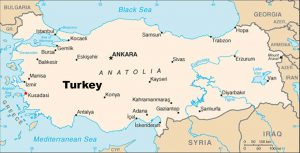
Kusadasi is a seaport in the western part of Turkey. From Kusadasi you are just an hour away from the historic place called Ephesus. According to legend, Epheses or Ephesos was founded by the tribe of the Amazons, great female warriors. The name of the Ephesus is thought to have been derived from “Apasas”, the name of a city in the “Kingdom of Arzawa” meaning the “city of the Mother Goddess”. Ionian migrations to Ephesus began around 1200 BCE and Ephesus is chiefly known as a Ionian Greek city. Later, the Persians came and ruled for many years until the Ionian city-states rebelled against Persian rule in the 5th century BCE. Then Ephesus remained neutral and fortunately escaped the destruction suffered by so many other cities in the area. When you go to Ephesus, you will have the opportunity to see many ancient Greek ruins which are simply spectacular.
A. Questions on this reading.
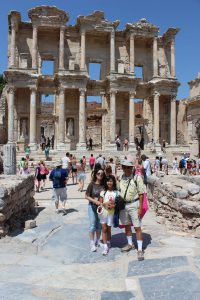
They call this place the library in Ephesus. Just imagine how it would like before it was ruined. Perhaps many people would go there to read and study the arts at that time.
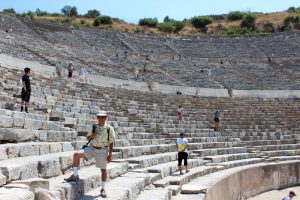
This is the biggest coliseum in the Ionian ruins of Ephesus.

The site of the ruins is spectacular and historic. However, you have to endure the over 100 degree weather while visiting the ruins.
Another thing you can do while in Kusadasi is to see the shows on Turkish Folkloric dances and of course belly dancing which are spectacular, artistic and exotic.
Turkish dances
Turkish folk dances are performed at weddings, engagement ceremonies, when sending young men off to perform their military service, at national and religious festivals, after victories, going to and coming back from the high plateaus and at meetings such as ferfene, yaren talks, barana or sira gezmesi. Some dances reflect natural events or daily life, and others treat social events and matters of the heart. For example, the Kimil dance from Urfa province portrays a kind of pest that harms the crops and the way that villagers attempt to deal with it.
B. Questions on Turkish dances.
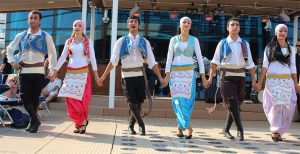
Turkish dancers demonstrate traditional folk dancing with native costumes.
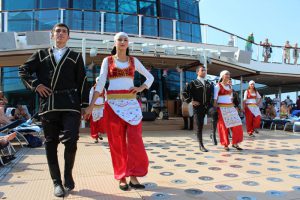
Paired dancing with women in red and men in black in native costumes.

Belly dancing is still the most well-known Middle Eastern dance that all cultures are familiar with. This lady dances very well.
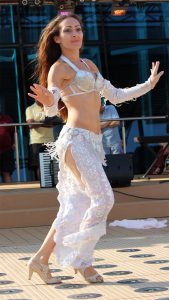
This beautiful young belly dancer captured the attention of everyone for her beautiful, gyrating, and pulsating moves that men and women could not take their eyes from her.
Belly Dancing
The word “belly dancing” is derived from the French word “Dance de ventre” or dance of the stomach. In actuality belly dance is an Arabic dance (Arabic: رقص شرقي, translated as “Raqs sharqi” meaning “oriental dancing.”) This Arabic dance is an expressive dance which originatated in Egypt and emphasizes complex movements or gyration of the torso.
Some people in the Middle East believe the believe that belly dancing helps prepare a woman’s body to give birth. Others believe that belly dancing dancing is spiritual and gives women power and strength. In the 1970s and 1980s the feminist movement rediscovered the art of belly dancing and they believe it empowers women and gives her assurance of her physical and spiritual strength through her body movements.
In countries like Turkey, Egypt, Saudi Arabia and other Middle Eastern countries belly dancing is very popular as well as cultural and ritual. Belly dancing attracts people of different cultures and it is the main attraction for tourist who visit Middle Eastern countries like Turkey, Egypt and Saudi Arabia. Belly dancing is energetic, exciting, exotic and erotic which Middle Easterners believe give women power physically, mentally, and spiritually.
But there is more to belly dancing. It is a healing power for many women. Physically it tones the muscles of the body. The gyrations and side to side movements of the hips strengthen muscles and joints. The posture of belly dancers helps them with their posture and spinal alignment.
Emotionally, belly dancing helps women gain “self-esteem” and inner confidence. It gives them a social outlet with other women and offers them the opportunity for FUN.
Spiritually it connects women with their femininity, their spiritual being and the opportunity to comment with other women through their movements and body physique.
Belly dancing can improve the self-esteem of women through her physical strength and posture. It helps improve her posture and body alignment, and it creates a strong self-image through their high raised head position and eye contact with others as she dances.
Belly dancing helps women control their blood pressure as it helps them to be in control of their body and be calm and confident through her body movements. This helps regulate their blood pressure because their inner confidence and control creates regular blood pressure.
The healing for women also comes as a result of meeting other women and having a close or life-long relationship with women because of their involvement with the dance. Women who can belly dance can travel anywhere and feel a sense of belonging with other belly dancers. In fact, belly dancers can easily connect with complete strangers because of the passion in the dance.
No doubt, belly dancing has healing power and it has helped many women of all cultures, not just Middle Eastern women who practice this dance. Belly dancing is like “yoga” where the energy of “self” comes from within and then transcends to the spirituality outside of the body.
C. Questions on the article on “belly dancing.”
